Sistine Ceiling 2.0: Restoration of the Carracci Gallery Frescoes.
Ruth Osborne
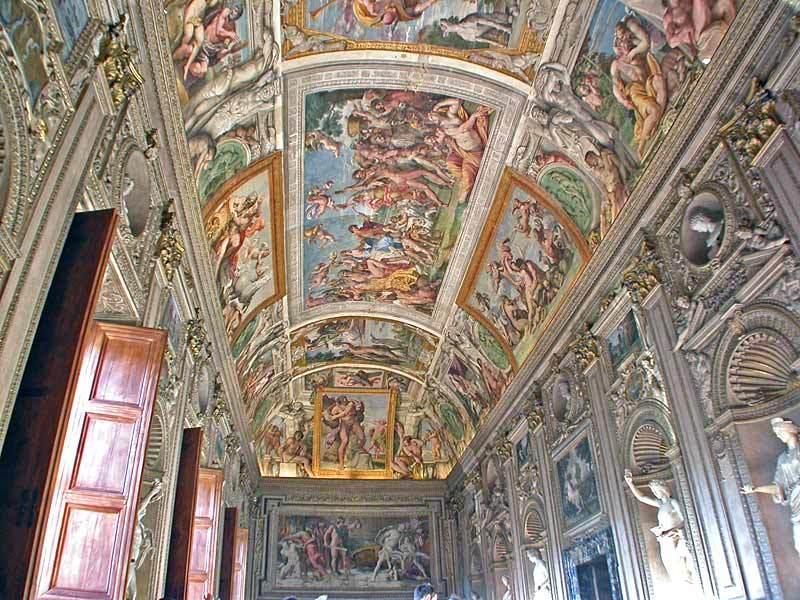
Carracci Gallery, 2014.
This past February, announcements were made concerning the restoration project planned for the frescoes adorning the Carracci Gallery at the Palazzo Farnese in Rome.
This is no new thing for Annibale Carracci’s monumental cycle The Love of the Gods (1597-1606), which had already undergone “consolidation” only a few decades after completion under Baroque painter Carlo Maratta later in the seventeenth-century. [1] Since the beginning of the twentieth-century, the frescoes have undergone patched cleaning in 1923, 1936, and 1994 (though it is not clear just how much was accomplished during this latest effort beyond a general assessment of the issues).
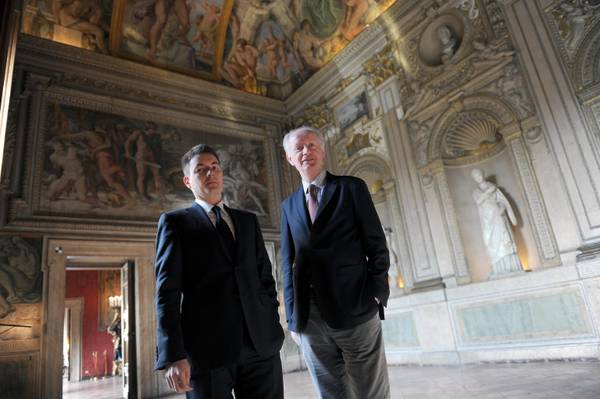
Erkki Maillard, French Deputy Ambassador (right), and Bertrand du Vignaud, President of WMF Europe (right), in the Carracci Gallery. Courtesy: ANSAmed, 2014.
The French government, which has inhabited the historic building since 1874, first opened the gallery and palazzo to the public in 1936. Today it houses both the French Embassy and the Ecole Française de Rome, with reportedly small groups of visitors coming to see the Carracci frescoes only by appointment. According to the project’s Press Release from the New York-based non-profit World Monuments Fund:
“Today conservation is necessary to ensure that the paintings in the gallery do not deteriorate or become harmed by structural problems in the ceiling. The campaign of 1994, realized under the direction of the French Service des Monuments historiques, assembled information on the condition of the vault that led to some proposed solutions to conservation issues, but it was not possible at the time to secure sufficient funding to carry out the proposed treatments. The previous analysis will be helpful in developing the conservation program for the painted decorations, stucco, and gilding that adorn the room. Work is scheduled to begin this year and will be coordinated by WMF in collaboration with local heritage authorities and international experts.”
Besides WMF, the other groups that have joined together to help get the project off the ground are the French Embassy in Italy, the Italian Ministry of Cultural Heritage, and the Foundation de l’Orangerie (connected with French banking giant BNP Paribas). [2]
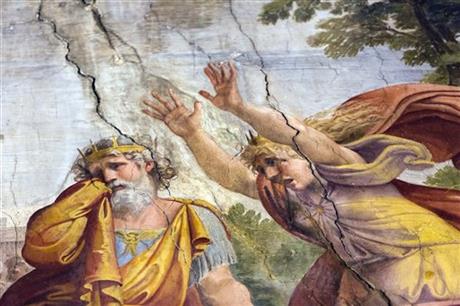
Cracking of Carracci’s depiction of Queen Cassiopeia and King Cepheus of Ethiopia. Courtesy: Domenico Stinellis/AP, 2014.
Restorers will first go about cleaning off layers of dirt and old overpainting from areas that had been restored in previous years. They will then work to fill any extensive cracks and repair water damage. [3] According to WMF, this is the first time in the gallery’s history that the side walls, in addition to the ceiling in its entirety, will be treated. No doubt there is much restorers hope to glean from this work, more so than a simple stabilization of Carracci’s 400 year-old masterpiece. It is also understood that this year-long project will likely uncover some secrets about the frescoes’ condition. As Italian culture ministry official Rossella Vodret said to the New York Times in 2012, the work of the restorers will hopefully aid in “determining which hands painted which section” – Annibale’s, Agostino’s, or others from their workshop. She added emphasis on the “scientific endeavor” of this project. Meanwhile, scholars who have shown concern towards this massive overhaul are deemed “purists.” [4]
Objections arise not because of any “purist” impulses but because of (well-founded) concerns about the complex nature and (intended or un-intended) aesthetic consequences of comprehensive, long term, high cost, high-profile, heavily sponsored programs that aim at a single definitive comprehension to a cluster of real, feared or assumed problems. And why should the matter be decided by scientists alone? In the Times’ coverage of this project two years ago, an interesting statement was made by Vodret: “We are certain that if problems arise, the intelligence and professional qualities of the experts involved will win out.” [5] But precisely which experts? What kind of one-sided expertise? Ancient works of art are primarily artistic and historical artifacts. Any proposed treatment must take those factors into consideration – and, certainly, scientists alone are not competent in those vital areas. For example, removing all previous (historic) repairs will likely expose injuries that gave rise to the repainting in the first place. If it does, will those injuries be repainted again to the standards and tastes of the twenty-first century or left as wrecked passages? There is talk of a threat from water infiltration. Is that a substantive threat? Does the roof leak? Do gutters need to be replaced? Is the building affected by rising damp?
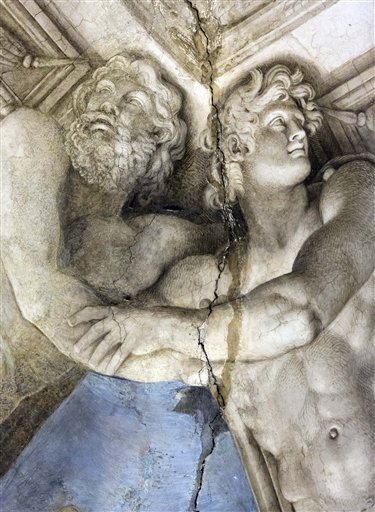
More damage over illusionistic corner frescoes. Courtesy: Domenico Stinellis/AP, 2014.
Is it just a scare? Alleged conservation threats that were cited in the past on other major projects can prove unfounded when challenged – as was the case with the claimed “glue pox” that was said (on no evidence) to be devouring the Sistine Chapel ceiling at a dramatically escalating rate.
The project, which is underway as of the beginning of March, was set in motion by a new committee of 30 scientific restoration specialists formed in 2009 to consider the ceiling’s treatments and make recommendations for future work. [5] The conglomerate of international non-profits mentioned above have chosen the reputable Italian restoration group ATI Farnese as the to carry out the project. $200,000 of the 1 million euros this project will entail has been allocated to preliminary studies of the ceiling (a portion provided for specifically by the Italian government). [6] A sense of immediacy to protect pervades discussion of the work to be done: “The value placed on the gallery meant that it has been restored at times in the past, including an urgent fix ordered in 1994 when the ceiling threatened to collapse. Now, new cracks and leaks that threatened the masterpieces inside have demanded an immediate response to protect what many call a significant piece of cultural heritage. ” [7] French Deputy Ambassador Erkki Maillard lists issues of cracking along the side panels and the vault, concern for infiltration of water damage and lifting of paint, and “paintings obscured by time that also need to be cleaned.” [8] These delicately and poignantly illusionistic frescoes run the risk of experiencing a traumatic face-lift. Restorers will likely uncover unfortunate remnants from the partial cleanings of the 1920s and 30s. This could, in turn, either lead them back to page one, or set them off on a path from which there is no return.
The grandiose treatment is projected to last at least until spring 2015, when the gallery will finally reopen to the public. One must also not fail to take into consideration the impact of the growing tourist industry on the newly-cleaned frescoes, once revealed. According to Maillard, the current policy for outside visitors is previously-reserved small weekly tours. [9] While these will be put on hold during restoration over the next year, what might be the result of the frescoes unveiling next spring? Will it bring in a greater demand for viewings? How will the French Embassy respond to an increased interest in this monumental piece of Italian artistic heritage? The sharp rise in visitors to the Sistine Chapel in recent years has undoubtedly placed a new fear in the Vatican for the well-being of their own crowning masterpiece (Read the ArtWatch UK article here). The final statement from WMF as to the Carracci project’s importance: “Once completed, the current conservation project will allow the Palazzo Farnese and the Carracci gallery to be accessible to the public more regularly, following years of restricted access to this cultural treasure.” [10]
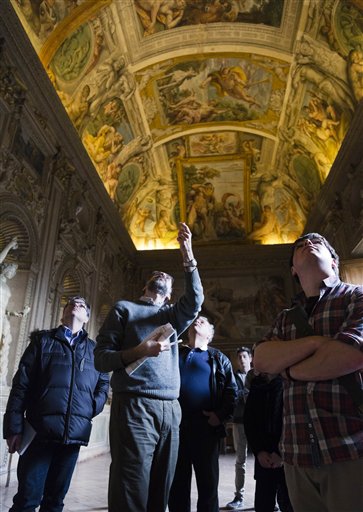
Guided tour through Carracci Gallery in February 2014. Courtesy: Domenico Stinellis/AP, 2014.
——–
[1] “Project: Carracci Gallery at the Palazzo Farnese,” WMF Program: Field Project. World Monuments Fund. http://www.wmf.org/project/carracci-gallery-palazzo-farnese (last accessed 21 March 2014).
[2] Press Release: “World Monuments Fund & its Partners Announce Project to Restore The Famous Carracci Gallery in Rome’s Palazzo Farnese,” http://www.wmf.org/sites/default/files/press_releases/Palazzo%20Farnese%20Release.pdf (last accessed 28 March 2014).
[3] Frances D’Emilio, AP, “French Embassy’s glorious ceiling in Renaissance palazzo to be rescued by modern day ‘Medicis’,” 26 February 2014. Newser. http://www.newser.com/article/5a9be14133f74636886aa0f1dde7e4e6/french-embassys-glorious-ceiling-in-renaissance-palazzo-to-be-rescued-by-modern-day-medicis.html (last accessed 28 March 2014).
[4] Elisabetta Povoledo, “Restoration Planned for Carracci Gallery in Rome,” New York Times. 10 October 2012. http://artsbeat.blogs.nytimes.com/2012/10/10/restoration-planned-for-carracci-gallery-in-rome/?
_php=true&_type=blogs&_php=true&_type=blogs&_r=1 (last accessed 21 March 2014).
[5] Ibid.
[6] Sandra Cordon, ANSA, “Palazzo Farnese’s Carracci gallery to shine anew: Restoration begins on Baroque masterpieces in French embassy,” 27 February 2014. La Gazzetta del Mezzogiorno. http://www.lagazzettadelmezzogiorno.it/english/palazzo-farnese-s-carracci-gallery-to-shine-anew-no698007 (last accessed 21 March 2014).
[7] Guillemette de la Borie “À Rome, les Carrache sous bâche,” 27 February 2014. La Croix.
http://www.la-croix.com/Culture/Actualite/A-Rome-les-Carrache-sous-bache-2014-02-27-1113125 (last accessed 14 March 2014).
[8] Cordon.
[9] Borie.
[10] D’Emilio.
[11] “Project: Carracci Gallery at the Palazzo Farnese,” WMF.

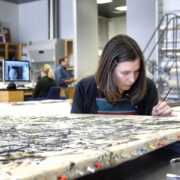

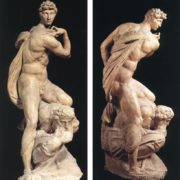
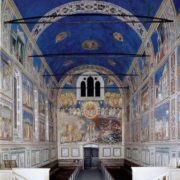
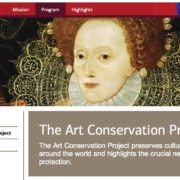
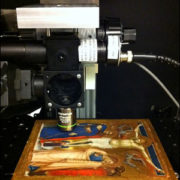



Leave a Reply
Want to join the discussion?Feel free to contribute!